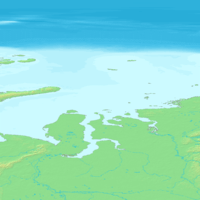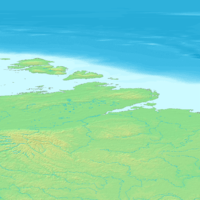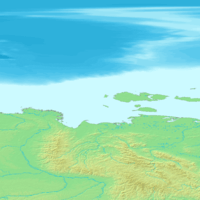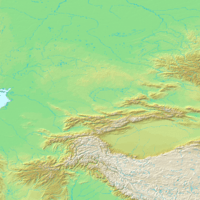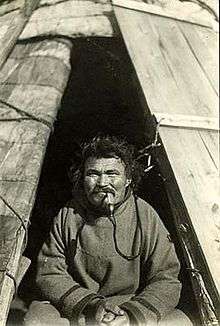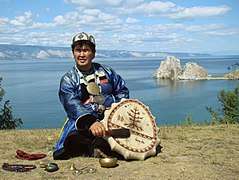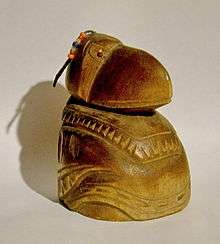Indigenous peoples of Siberia
Including the Russian Far East, the population of Siberia is around 33 million people. As a result of the 17th to 19th century Russian conquest of Siberia and the subsequent population movements during the Soviet era, the demographics of Siberia today is dominated by native speakers of Russian. There remain a considerable number of indigenous groups, between them accounting for below 10% of total Siberian population (about 4,500,000), some of which are distantly genetically related to indigenous peoples of the Americas.[1]
| ||||||||||
| Total population | ||||||||||
|---|---|---|---|---|---|---|---|---|---|---|
| 4,500,000 | ||||||||||
| Regions with significant populations | ||||||||||
| Siberia | ||||||||||
| Languages | ||||||||||
| Russian Chukotko-Kamchatkan languages, Eskimo–Aleut languages, Nivkh languages, Mongolic languages, Tungusic languages, Turkic languages, Uralic languages, Yeniseian languages (Ket), Yukaghir languages | ||||||||||
| Religion | ||||||||||
| Buddhism, Christianity (Eastern Orthodoxy), Islam, Shamanism, Tengrism | ||||||||||
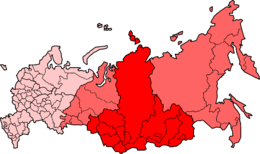
History
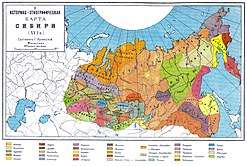
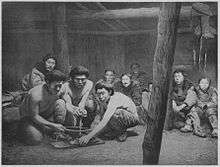
In Kamchatka the Itelmens' uprisings against Russian rule in 1706, 1731, and 1741, were crushed. During the first uprising the Itelmen were armed with only stone weapons, but in later uprisings they used gunpowder weapons. The Russian Cossacks faced tougher resistance from the Koryaks, who revolted with bows and guns from 1745 to 1756, and were even forced to give up in their attempts to wipe out the Chukchi in 1729, 1730-1, and 1744-7.[2] After the Russian defeat in 1729 at Chukchi hands, the Russian commander Major Dmitry Pavlutsky was responsible for the Russian war against the Chukchi and the mass slaughters and enslavement of Chukchi women and children in 1730-31, but his cruelty only made the Chukchis fight more fiercely.[3] A war against the Chukchis and Koryaks was ordered by Empress Elizabeth in 1742 to totally expel them from their native lands and erase their culture through war. The command was that the natives be "totally extirpated" with Pavlutskiy leading again in this war from 1744-47 in which he led to the Cossacks "with the help of Almighty God and to the good fortune of Her Imperial Highness", to slaughter the Chukchi men and enslave their women and children as booty. However this phase of the war came to an inconclusive end, when the Chukchi forced them to give up by killing Pavlutskiy and decapitating him.[4]
The Russians were also launching wars and slaughters against the Koryaks in 1744 and 1753-4. After the Russians tried to force the natives to convert to Christianity, the different native peoples like the Koryaks, Chukchis, Itelmens, and Yukaghirs all united to drive the Russians out of their land in the 1740s, culminating in the assault on Nizhnekamchatsk fort in 1746.[5] Kamchatka today is European in demographics and culture with only 2.5% of it being native, around 10,000 from a previous number of 150,000, due to infectious diseases, such as smallpox, mass suicide and the mass slaughters by the Cossacks after its annexation in 1697 of the Itelmen and Koryaks throughout the first decades of Russian rule.[6] The genocide by the Russian Cossacks devastated the native peoples of Kamchatka and exterminated much of their population.[7][8] In addition to committing genocide the Cossacks also devastated the wildlife by slaughtering massive numbers of animals for fur.[9] 90% of the Kamchadals and half of the Vogules were killed from the eighteenth to nineteenth centuries and the rapid genocide of the indigenous population led to entire ethnic groups being entirely wiped out, with around 12 exterminated groups which could be named by Nikolai Iadrintsev as of 1882. Much of the slaughter was brought on by the fur trade.[10]
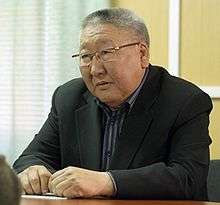
In the 17th century, indigenous peoples of the Amur region were attacked and colonized by Russians who came to be known as "red-beards".[11] The Russian Cossacks were named luocha (羅剎), rakshasa by Amur natives, after demons found in Buddhist mythology. They feared the invaders as they ruthlessly colonized the Amur tribes, invaders who were subjects of the Qing dynasty during the Sino–Russian border conflicts.[12]
_02_(cropped).jpg)
The regionalist oblastniki was, in the 19th century, among the Russians in Siberia who acknowledged that the natives were subjected to violence of almost genocidal proportions by the Russian colonization. They claimed that they would rectify the situation with their proposed regionalist policies.[13] The colonizers used slaughter, alcoholism and disease to bring the natives under their control, some small nomadic groups essentially disappeared, and much of the evidence of their obliteration has itself been destroyed, with only a few artifacts documenting their presence remaining in Russian museums and collections.[14]
In 1918-1921 there was a violent revolutionary upheaval in Siberia. Russian Cossacks under Captain Grigori Semionov established themselves as warlords by crushing the indigenous peoples who resisted colonization.[15] The Russian colonization of Siberia and conquest of its indigenous peoples has been compared to European colonization in the United States and its natives, with similar negative impacts on the natives and the appropriation of their land. However Siberian experience was very different, as settlement was not resulted to dramatic native depopulation.[16] The Slavic Russians outnumber all of the native peoples in Siberia and its cities except in Tuva and Sakha (where the Tuvans and Yakuts serve as the majority ethnic groups respectively), with the Slavic Russians making up the majority in Buryatia and the Altai Republic, outnumbering the Buryat and Altaian natives. The Buryats make up only 29% of their own Republic, and Altai is only one-third, and the Chukchi, Evenks, Khanty, Mansi, and Nenets are outnumbered by non-natives by 90% of the population. The Czars and Soviets enacted policies to force natives to change their way of life, while rewarding ethnic Russians with the natives’ reindeer herds and wild game they had confiscated. The reindeer herds have been mismanaged to the point of extinction.
Overview
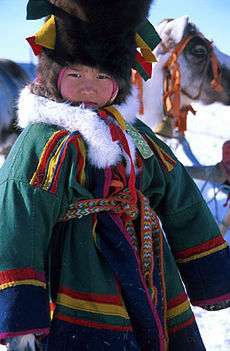
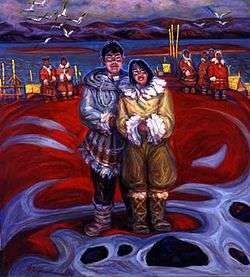
Classifying the diverse population by language, it includes speakers of the following language families (number of speakers reflect the 2002 Russian census):
- Uralic
- Yukaghir (nearly extinct)
- Turkic[17][18]
- Yakut (456,288 speakers)
- Dolgan (population: 7,261; speakers: 4,865)
- Tuvan (population: 243,442; speakers: 242,754)
- Tofa (population: 837; speakers: 378)
- Khakas (population: 75,622; speakers: 52,217)
- Shor (population: 13,975; speakers: 6,210)
- Siberian Tatar (populations: 6,779)
- Chulym (population: 656; speakers: 270)
- Altai (some 70,000 speakers)
- Mongolic (some 400,000 speakers)
- Tungusic (some 80,000 speakers)
- Ob-Yeniseian
- Ket (population: 1600; some 210 speakers)
- Chukotko-Kamchatkan (some 25,000 speakers)
- Nivkh (some 200 speakers)
Simplified, the indigenous peoples of Siberia listed above can be put into four groups,
- Uralic
- Altaic
- Yeniseian
- Paleosiberian ("other")
Altaic has not been proven to be a language family, a phylogenetic unit. It may be a Sprachbund. Paleosiberian is simply a geographic term of convenience. Here, these two terms are listed just to serve as portal-like starting points – without suggesting genetic considerations.
Uralic group
Khanty and Mansi
The Khanty (obsolete: Ostyaks) and Mansi (obsolete: Voguls) live in Khanty–Mansi Autonomous Okrug, a region historically known as "Yugra" in Russia. By 2013, oil and gas companies had already devastated much of the Khanty tribes' lands. In 2014 the Khanty-Mansi regional parliament continued to weaken legislation that had previously protected Khanty and Mansi communities. Tribes' permission was required before oil and gas companies could enter their land.[19]
Yukaghir group
Yukaghir is spoken in two mutually unintelligible varieties in the lower Kolyma and Indigirka valleys. Other languages, including Chuvantsy, spoken further inland and further east, are now extinct. Yukaghir is held by some to be related to the Uralic languages in the Uralic–Yukaghir family.
The Yukaghirs (self-designation: одул odul, деткиль detkil) are people in East Siberia, living in the basin of the Kolyma River. The Tundra Yukaghirs live in the Lower Kolyma region in the Sakha Republic; the Taiga Yukaghirs in the Upper Kolyma region in the Sakha Republic and in Srednekansky District of Magadan Oblast. By the time of Russian colonization in the 17th century, the Yukaghir tribal groups (Chuvans, Khodyns, Anauls, etc.) occupied territories from the Lena River to the mouth of the Anadyr River. The number of the Yukaghirs decreased between the 17th and 19th centuries due to epidemics, internecine wars and Tsarist colonial policy. Some of the Yukaghirs have assimilated with the Yakuts, Evens, and Russians. Currently Yukaghirs live in the Sakha Republic and the Chukotka Autonomous Okrug of the Russian Federation. According to the 2002 Census, their total number was 1,509 people, up from 1,112 recorded in the 1989 Census.
Mongolic group
The Buryats number approximately 436,000, which makes them the largest ethnic minority group in Siberia. They are mainly concentrated in their homeland, the Buryat Republic, a federal subject of Russia. They are the northernmost major Mongol group.[20]
Buryats share many customs with their Mongolian cousins, including nomadic herding and erecting huts for shelter. Today, the majority of Buryats live in and around Ulan Ude, the capital of the republic, although many live more traditionally in the countryside. Their language is called Buryat.
Turkic group
The most important examples for Shamanism in Siberia are Yakuts, Dolgans and Tuvans.
Most Siberian Tatars are Sunni Muslims. Members of the Shors practice Russian Orthodox Christianity, animism or shamanism.
Tungusic group
The Evenks live in the Evenk Autonomous Okrug of Russia.
The Udege, Ulchs, Evens, and Nanai (also known as Hezhen) are also indigenous peoples of Siberia, and are known to share genetic affinity to Indigenous Peoples of the Americas.
"Paleosiberian" groups
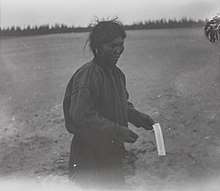
Four small language families and isolates, not known to have any linguistic relationship to each other, compose the Paleo-Siberian languages:
- 1. The Chukotko-Kamchatkan family, sometimes known as Luoravetlan, includes Chukchi and its close relatives, Koryak, Alutor and Kerek. Itelmen, also known as Kamchadal, is also distantly related. Chukchi, Koryak and Alutor are spoken in easternmost Siberia by communities numbering in the dozens (Alutor) to thousands (Chukchi). Kerek is now extinct, and Itelmen is now spoken by fewer than 10 people, mostly elderly, on the west coast of the Kamchatka Peninsula.
- 2. Yukaghir is spoken in two mutually unintelligible varieties in the lower Kolyma and Indigirka valleys. Other languages, including Chuvantsy, spoken further inland and further east, are now extinct. Yukaghir is held by some to be related to the Uralic languages.
- 3. Ket is the last survivor of the Yeniseian family along the middle of the Yenisei River and its tributaries. It has recently been claimed to be related to the Na-Dene languages of North America, though this hypothesis has met with mixed reviews among historical linguists. In the past, attempts have been made to relate it to Sino-Tibetan, North Caucasian, and Burushaski.
Relationship to Indigenous peoples of the Americas
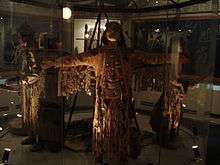
Paleo-Indians from modern day Siberia are thought to have crossed into the Americas across the Beringia land bridge between 40,000-13,000 years ago.
Analysis of genetic markers has also been used to link the two groups of indigenous peoples. Studies focused on looking at markers on the Y chromosome, which is always inherited by sons from their fathers. Haplogroup Q is a unique mutation shared among most indigenous peoples of the Americas. Studies have found that 93.8% of Siberia's Ket people's and 66.4% of Siberia's Selkup people's possess the mutation.[21] The principal-component analysis suggests a close genetic relatedness between some North American Amerindians (the Chipewyan [Ojibwe] and the Cheyenne) and certain populations of central/southern Siberia (particularly the Kets, Yakuts, Selkups, and Altaians), at the resolution of major Y-chromosome haplogroups.[22] This pattern agrees with the distribution of mtDNA haplogroup X, which is found in North America, is absent from eastern Siberia, but is present in the Altaians of southern central Siberia.[22]
Culture and customs
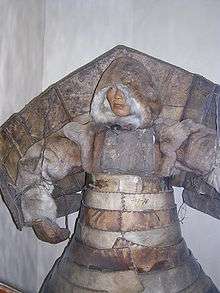
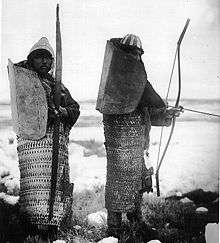
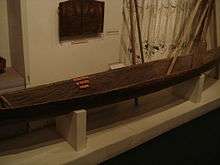
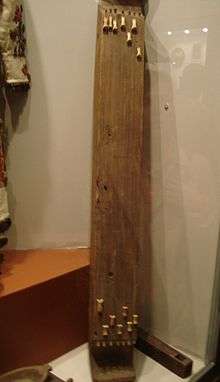
The Chukchi wore laminar armour of hardened leather enforced by wood and bones.[24][25]
Kutkh (also Kutkha, Kootkha, Kutq Kutcha and other variants, Russian: Кутх), is a raven spirit traditionally revered by the Chukchi and other Siberian tribal groups. He is said to be very powerful.[26]
Toko'yoto or the "Crab" was the Chukchi god of the sea.[27]
Nu'tenut is the chief god of the Chukchi. [28]
The Chukchi also respect reindeer in both mortal and holy life. They have several rituals involving them. [29]
The Supreme Deity of the Yukaghirs is called Pon, meaning "Something." [30] He is said to be very powerful.[31]
Literature
- Rubcova, E.S.: Materials on the Language and Folklore of the Eskimoes, Vol. I, Chaplino Dialect. Academy of Sciences of the USSR, Moskva * Leningrad, 1954
- Menovščikov, G. A. (= Г. А. Меновщиков) (1968). "Popular Conceptions, Religious Beliefs and Rites of the Asiatic Eskimoes". In Diószegi, Vilmos (ed.). Popular beliefs and folklore tradition in Siberia. Budapest: Akadémiai Kiadó.
- Barüske, Heinz: Eskimo Märchen. Eugen Diederichs Verlag, Düsseldorf and Köln, 1969.
- Merkur, Daniel: Becoming Half Hidden / Shamanism and Initiation Among the Inuit. Acta Universitatis Stockholmiensis / Stockholm Studies in Comparative Religion. Almqvist & Wiksell, Stockholm, 1985.
- Kleivan, I. and Sonne, B.: Eskimos / Greenland and Canada. (Series: Iconography of religions, section VIII /Arctic Peoples/, fascicle 2). Institute of Religious Iconography • State University Groningen. E.J. Brill, Leiden (The Netherland), 1985. ISBN 90-04-07160-1.
See also
- Ancient Beringian, Siberian indigenous people.
- History of Siberia
- Demographics of Siberia
- First All Union Census of the Soviet Union
- Indigenous people
- Indigenous peoples of the Americas
- List of ethnic groups
- Y-DNA haplogroups in populations of Central and North Asia
- Pomors
- Kola Norwegians
- Uralic languages
- Shamanism in Siberia
- List of indigenous peoples of Russia
- List of small-numbered indigenous peoples of Russia
- Small-numbered indigenous peoples of Extreme North
Citations
- Zimmer, Carl (5 June 2019). "Who Were the Ancestors of Native Americans? A Lost People in Siberia, Scientists Say". nytimes.com. The New York Times Company. Retrieved 5 April 2020.
Dr. Willerslev's team found DNA in the Kolyma skull as well. A small fraction of that individual’s ancestry came from Ancient North Siberians. But most of it came from a new population. Dr. Willerslev and his colleagues call them the Ancient Paleo-Siberians.
The DNA of the Ancient Paleo-Siberians is remarkably similar to that of Native Americans. Dr. Willerslev estimates that Native Americans can trace about two-thirds of their ancestry to these previously unknown people.
One reason that the Ancient Paleo-Siberians were unknown until now is that they were mostly replaced by a third population of people with a different East Asian ancestry. This group moved into Siberia only in the past 10,000 years — and they are the progenitors of most living Siberians. - Black, Jeremy (1 October 2008). War and the World: Military Power and the Fate of Continents, 1450-2000. Yale University Press. ISBN 978-0300147698. Retrieved 4 May 2018 – via Google Books.
- Forsyth 1994, pp. 145-6.
- Forsyth 1994, p. 146.
- Forsyth 1994, p. 147.
- Jack 2008, p. 388.
- "Condé Nast's Traveler, Volume 36" 2001, p. 280.
- "Yearbook" 1992, p. 46.
- Mote 1998, p. 44.
- Etkind 2013, p. 78.
- Stephan 1996, p. 64.
- Emory Endeavors: Transnational Encounters in Asia (PDF). CreateSpace Independent Publishing Platform. 2012. ISBN 978-1475138795. Retrieved 8 April 2020 – via Emory College of Arts and Sciences | Department of History.
- Wood 2011, pp. 89–90.
- Bobrick, Benson (15 December 2002). "How the East Was Won". The New York Times. Archived from the original on 24 September 2017. Retrieved 4 May 2018.
- Bisher 2006.
- Batalden 1997, p. 36.
- "4.1. National Composition of Population". Russian Federation 2002 census. Archived from the original on 9 June 2011. Retrieved 16 September 2010.
- "4.4. Spreading of Knowledge of Languages (except Russian)". Russian Federation 2002 census. Archived from the original on 9 June 2011. Retrieved 31 July 2007.
- "Reindeer herders take on Russian oil-giant as tribal rights in Siberia weakened". Survival International. 13 May 2014. Retrieved 1 September 2014.
- The New Encyclopædia Britannica, 15th Edition. (1977). Vol. II, p. 396. ISBN 0-85229-315-1.
- "Learning Center :: Genebase Tutorials". Genebase.com. 22 October 1964. Archived from the original on 17 November 2013. Retrieved 27 September 2013.
- Bortolini, MC; Salzano, FM; Thomas, MG; et al. (2003). "Y-chromosome evidence for differing ancient demographic histories in the Americas". Am. J. Hum. Genet. 73 (3): 524–39. doi:10.1086/377588. PMC 1180678. PMID 12900798.
- "Tlingit, Eskimo and Aleut armors". Kunstamera. Archived from the original on 22 February 2014. Retrieved 10 February 2014.
- http://www.kunstkamera.ru/en/museum_exhibitions/encyclopedia/america/military_science/tlingit_eskimo_and_aleut_armors
- "KUNSTKAMERA Tlingit, Eskimo and Aleut armors". 22 February 2014. Archived from the original on 22 February 2014.
- Krasheninnikov, Stepan P. (1972). "The Kamchadal Beliefs About God, the Creation of The World and the Tenets of their Religion". Explorations of Kamchatka 1735-1741. Translated by Crownheart-Vaughn, E.A.P. Portland, OR: Oregon Historical Society. pp. 238–243 – via www.nordic-life.org.
- Acta Universitatis Stockholmiensis: Stockholm studies in comparative religion. Almqvist & Wiksell. 1961. p. 68.
- Waldemar Bogoras (1909). The Chukchee. E.J. Brill Limited. p. 306.
- Malandra, W. W. "The Concept of Movement in History of Religions: A Religio-Historical Study of Reindeer in the Spiritual Life of North Eurasian Peoples." Numen, Vol. 14, Fasc. 1. BRILL, 1967, pp. 23–69.
- Lurker, Manfred (2004). The Routledge dictionary of gods and goddesses, devils and demons (2nd ed.). London: Taylor & Francis e-Library. p. 153. ISBN 0203643518.
- Norenzayan, Ara (2013). Big Gods: How Religion Transformed Cooperation and Conflict. Princeton University Press. p. 129. ISBN 9781400848324.
References
- Batalden, Stephen K. (1997). The Newly Independent States of Eurasia: Handbook of Former Soviet Republics. Contributor Sandra L. Batalden (revised ed.). Greenwood Publishing Group. ISBN 978-0897749404. Retrieved 24 April 2014.
- Bisher, Jamie (16 January 2006). White Terror: Cossack Warlords of the Trans-Siberian. Routledge. p. 492. ISBN 978-1135765958. Retrieved 24 April 2014.
- Bobrick, Benson (15 December 2002). "How the East Was Won". THE NEW YORK TIMES. Retrieved 24 May 2014.
- Black, Jeremy (2008). War and the World: Military Power and the Fate of Continents, 1450-2000. Yale University Press. ISBN 978-0300147698. Retrieved 24 April 2014.CS1 maint: ref=harv (link)
- Etkind, Alexander (2013). Internal Colonization: Russia's Imperial Experience. John Wiley & Sons. ISBN 978-0745673547. Retrieved 24 April 2014.CS1 maint: ref=harv (link)
- Forsyth, James (1994). A History of the Peoples of Siberia: Russia's North Asian Colony 1581-1990 (illustrated, reprint, revised ed.). Cambridge University Press. ISBN 978-0521477710. Retrieved 24 April 2014.CS1 maint: ref=harv (link)
- Jack, Zachary Michael, ed. (2008). Inside the Ropes: Sportswriters Get Their Game On. U of Nebraska Press. ISBN 978-0803219076. Retrieved 24 April 2014.CS1 maint: ref=harv (link)
- Kang, Hyeok Hweon (2013). "Big Heads and Buddhist Demons: The Korean Musketry Revolution and Northern Expeditions of 1654 and 1658". Journal of Chinese Military History. 2 (2): 127–189. doi:10.1163/22127453-12341256.
- Levene, Mark (2005). Genocide in the Age of the Nation State: Volume 2: The Rise of the West and the Coming of Genocide. I.B.Tauris. ISBN 978-0857712899. Retrieved 24 April 2014.CS1 maint: ref=harv (link)
- Mote, Victor L. (1998). Siberia: worlds Apart. Westview series on the post-Soviet republics (illustrated ed.). Westview Press. ISBN 978-0813312989. Retrieved 24 April 2014.CS1 maint: ref=harv (link)
- Pesterev, V. (2015). Siberian frontier: the territory of fear. Royal Geographical Society (with IBG), London.CS1 maint: ref=harv (link)
- Stephan, John J. (1996). The Russian Far East: A History (illustrated, reprint ed.). Stanford University Press. ISBN 978-0804727013. Retrieved 24 April 2014.CS1 maint: ref=harv (link)
- Wood, Alan (15 April 2011). Russia's Frozen Frontier: A History of Siberia and the Russian Far East 1581 - 1991 (illustrated ed.). A&C Black. ISBN 978-0340971246. Retrieved 24 April 2014, pp. 89–90.
- Condé Nast's Traveler, Volume 36. Condé Nast Publications. 2001. Retrieved 24 April 2014.CS1 maint: ref=harv (link)
- Yearbook. Contributor International Work Group for Indigenous Affairs. International Work Group for Indigenous Affairs. 1992. Retrieved 24 April 2014.CS1 maint: others (link) CS1 maint: ref=harv (link)
External links
- Russian Association of Indigenous Peoples of the North
- UNESCO Red Book on endangered languages: Northeast Asia
- Endangered Uralic Peoples
- Minority languages of Russia on the Net
- The Red Book of the peoples of the Russian Empire
- Survival International page on the Siberian Tribes
- L'auravetl'an Indigenous Information Network by Indigenous Peoples of Russia
- (in Russian) В погоне за малыми, an article about treatment of minorities in the Russian Empire, Kommersant-Money, October 25, 2005
- Mapping Indigenous Siberia: Spatial Changes and Ethnic Realities, 1900–2010. Ivan Sablin & Maria Savelyeva
